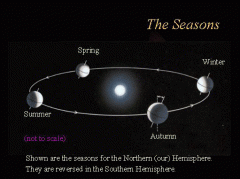Tonight at approximately 11 p.m. EDT, the Earth reaches aphelion, that point in its orbit when it is furthest from the Sun. Being July, one might wonder why it’s so dang hot (at least in the Northern Hemisphere, where the majority of Earth’s population resides on the majority of Earth’s land mass) if we’re farther from the sun than we are at any other time of the year.
The answer, as many of you know, is that Earth’s seasons are not caused by its distance from the Sun. Instead, they are caused by the tilt of its axis. It’s easiest to visualize with a picture:
Earth is always tilted 23.5 degrees from the plane of its orbit around the sun, which means that for any given part of the year, one hemisphere is tilted toward the Sun, and for the other part of the year, it’s tilted away from the Sun.* When your hemisphere is tilted toward the Sun, your day is longer; when it’s tilted away, it’s shorter. Longer days mean more time for the Sun’s rays to heat the atmosphere, the ground, the water–everything! The slight (<5 million km) difference in the Earth–Sun distance between aphelion and perihelion is negligible in terms of the planet’s heat budget.
Why is it hotter later in the summer than at the solstice? Well, that’s because the Earth’s surface stores heat; the shortening of day length after the solstice isn’t enough to overcome the storage of heat from the long days that preceded it. Which is why, even though June was a Very Hot Month this year in Florida, our hottest days are probably still ahead of us (sigh!).
*It’s important to realize that this doesn’t mean we flop back and forth in space on our axis, sometimes 23.5 degrees to one side, sometimes straight up and down, sometimes 23.5 degrees to some “other side.” The Earth’s axial tilt is constant. We do not flop back and forth over the course of six months.** It’s just that sometimes we are on one side of the Sun, and at other times, we are on the other side, so the sun appears north of the equator sometimes, and south of the equator at others.
**The Earth is wobbling slightly, but this effect, known as precession, is felt over thousands of years, not a few months.


